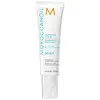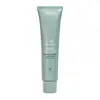What's inside
What's inside
 Key Ingredients
Key Ingredients

 Benefits
Benefits

 Concerns
Concerns

 Ingredients Side-by-side
Ingredients Side-by-side

Water
Skin ConditioningCocamidopropyl Betaine
CleansingStearyl Stearate
EmollientArgania Spinosa Shell Powder
AbrasiveGlycerin
HumectantPolysorbate 20
EmulsifyingArgania Spinosa Kernel Oil
EmollientHippophae Rhamnoides Fruit Oil
Skin ProtectingVaccinium Myrtillus Fruit Extract
Skin ConditioningSwertia Japonica Extract
Skin ConditioningRosa Canina Fruit Oil
EmollientAdansonia Digitata Seed Oil
EmollientFumaria Officinalis Extract
Skin ConditioningMelissa Officinalis Leaf Extract
Skin ConditioningSaccharum Officinarum Extract
MoisturisingAcer Saccharum Extract
Skin ConditioningEuphorbia Cerifera Wax
Citrus Limon Fruit Extract
MaskingCitrus Aurantium Dulcis Fruit Extract
MaskingHordeum Distichon Extract
Skin ProtectingJojoba Esters
EmollientCellulose
AbsorbentHydroxyethylcellulose
Emulsion StabilisingMenthol
MaskingGluconolactone
Skin ConditioningCocamidopropyl Dimethylamine
EmulsifyingHydroxyethyl Acrylate/Sodium Acryloyldimethyl Taurate Copolymer
Emulsion StabilisingEthylhexylglycerin
Skin ConditioningMenthyl Lactate
MaskingDipotassium Glycyrrhizate
HumectantPolyquaternium-7
Polysorbate 60
EmulsifyingSorbitan Isostearate
EmulsifyingGlucosyl Hesperidin
HumectantMethylpropanediol
SolventGuar Hydroxypropyltrimonium Chloride
Skin ConditioningButylene Glycol
HumectantCaprylyl Glycol
EmollientSodium Chloride
MaskingParfum
MaskingCitric Acid
BufferingGlycolic Acid
BufferingLactic Acid
BufferingSalicylic Acid
MaskingDidecyldimonium Chloride
EmulsifyingCetrimonium Chloride
AntimicrobialPhenoxyethanol
PreservativeSodium Acetate
BufferingSodium Benzoate
MaskingXanthan Gum
EmulsifyingLinalool
PerfumingLimonene
PerfumingWater, Cocamidopropyl Betaine, Stearyl Stearate, Argania Spinosa Shell Powder, Glycerin, Polysorbate 20, Argania Spinosa Kernel Oil, Hippophae Rhamnoides Fruit Oil, Vaccinium Myrtillus Fruit Extract, Swertia Japonica Extract, Rosa Canina Fruit Oil, Adansonia Digitata Seed Oil, Fumaria Officinalis Extract, Melissa Officinalis Leaf Extract, Saccharum Officinarum Extract, Acer Saccharum Extract, Euphorbia Cerifera Wax, Citrus Limon Fruit Extract, Citrus Aurantium Dulcis Fruit Extract, Hordeum Distichon Extract, Jojoba Esters, Cellulose, Hydroxyethylcellulose, Menthol, Gluconolactone, Cocamidopropyl Dimethylamine, Hydroxyethyl Acrylate/Sodium Acryloyldimethyl Taurate Copolymer, Ethylhexylglycerin, Menthyl Lactate, Dipotassium Glycyrrhizate, Polyquaternium-7, Polysorbate 60, Sorbitan Isostearate, Glucosyl Hesperidin, Methylpropanediol, Guar Hydroxypropyltrimonium Chloride, Butylene Glycol, Caprylyl Glycol, Sodium Chloride, Parfum, Citric Acid, Glycolic Acid, Lactic Acid, Salicylic Acid, Didecyldimonium Chloride, Cetrimonium Chloride, Phenoxyethanol, Sodium Acetate, Sodium Benzoate, Xanthan Gum, Linalool, Limonene
Water
Skin ConditioningSodium Methyl Cocoyl Taurate
CleansingCocamidopropyl Hydroxysultaine
CleansingSodium Chloride
MaskingSodium Cocoyl Isethionate
CleansingDisodium Cocoamphodiacetate
CleansingSalicylic Acid
MaskingGlucosamine Hcl
Andrographis Paniculata Extract
AstringentCentella Asiatica Extract
CleansingZinc PCA
HumectantMenthol
MaskingMenthyl Lactate
MaskingCitric Acid
BufferingSodium Hydroxide
BufferingParfum
MaskingBenzyl Alcohol
PerfumingLimonene
PerfumingLinalool
PerfumingGeraniol
PerfumingHydroxycitronellal
PerfumingBenzyl Salicylate
PerfumingTetrasodium Iminodisuccinate
Potassium Sorbate
PreservativeWater, Sodium Methyl Cocoyl Taurate, Cocamidopropyl Hydroxysultaine, Sodium Chloride, Sodium Cocoyl Isethionate, Disodium Cocoamphodiacetate, Salicylic Acid, Glucosamine Hcl, Andrographis Paniculata Extract, Centella Asiatica Extract, Zinc PCA, Menthol, Menthyl Lactate, Citric Acid, Sodium Hydroxide, Parfum, Benzyl Alcohol, Limonene, Linalool, Geraniol, Hydroxycitronellal, Benzyl Salicylate, Tetrasodium Iminodisuccinate, Potassium Sorbate
Ingredients Explained
These ingredients are found in both products.
Ingredients higher up in an ingredient list are typically present in a larger amount.
Citric Acid is an alpha hydroxy acid (AHA) naturally found in citrus fruits like oranges, lemons, and limes.
Like other AHAs, citric acid can exfoliate skin by breaking down the bonds that hold dead skin cells together. This helps reveal smoother and brighter skin underneath.
However, this exfoliating effect only happens at high concentrations (20%) which can be hard to find in cosmetic products.
Due to this, citric acid is usually included in small amounts as a pH adjuster. This helps keep products slightly more acidic and compatible with skin's natural pH.
In skincare formulas, citric acid can:
While it can provide some skin benefits, research shows lactic acid and glycolic acid are generally more effective and less irritating exfoliants.
Most citric acid used in skincare today is made by fermenting sugars (usually from molasses). This synthetic version is identical to the natural citrus form but easier to stabilize and use in formulations.
Read more about some other popular AHA's here:
Learn more about Citric AcidLimonene is a fragrance that adds scent and taste to a formulation.
It's found in the peel oil of citrus fruits and other plants such as lavender and eucalyptus. The scent of limonene is generally described as "sweet citrus".
Limonene acts as an antioxidant, meaning it helps neutralize free radicals.
When exposed to air, oxidized limonene may sensitize the skin. Because of this, limonene is often avoided by people with sensitive skin.
The term 'fragrance' is not regulated in many countries. In many cases, it is up to the brand to define this term. For instance, many brands choose to label themselves as "fragrance-free" because they are not using synthetic fragrances. However, their products may still contain ingredients such as essential oils that are considered a fragrance.
Learn more about LimoneneLinalool is a fragrance and helps add scent to products. It's derived from common plants such as cinnamon, mint, citrus, and lavender.
Like Limonene, this ingredient oxidizes when exposed to air. Oxidized linalool can cause allergies and skin sensitivity.
This ingredient has a scent that is floral, spicy tropical, and citrus-like.
Learn more about LinaloolMenthol is a compound found in mint plants, such as peppermint. In its pure form, it is a clear crystalline substance.
Menthol is known for its cooling sensation; however, the cooling is actually from your skin being sensitized. Menthol can worsen rosacea. We recommend speaking with a professional if you have concerns.
Menthol also has antimicrobial properties.
Learn more about MentholMenthyl lactate is an ester of menthol and lactic acid. It is often used as a cooling agent and fragrance.
When applied topically, this ingredient leaves a refreshing sensation like menthol, but is less irritating.
Parfum is a catch-all term for an ingredient or more that is used to give a scent to products.
Also called "fragrance", this ingredient can be a blend of hundreds of chemicals or plant oils. This means every product with "fragrance" or "parfum" in the ingredients list is a different mixture.
For instance, Habanolide is a proprietary trade name for a specific aroma chemical. When used as a fragrance ingredient in cosmetics, most aroma chemicals fall under the broad labeling category of “FRAGRANCE” or “PARFUM” according to EU and US regulations.
The term 'parfum' or 'fragrance' is not regulated in many countries. In many cases, it is up to the brand to define this term.
For instance, many brands choose to label themselves as "fragrance-free" because they are not using synthetic fragrances. However, their products may still contain ingredients such as essential oils that are considered a fragrance by INCI standards.
One example is Calendula flower extract. Calendula is an essential oil that still imparts a scent or 'fragrance'.
Depending on the blend, the ingredients in the mixture can cause allergies and sensitivities on the skin. Some ingredients that are known EU allergens include linalool and citronellol.
Parfum can also be used to mask or cover an unpleasant scent.
The bottom line is: not all fragrances/parfum/ingredients are created equally. If you are worried about fragrances, we recommend taking a closer look at an ingredient. And of course, we always recommend speaking with a professional.
Learn more about ParfumSalicylic Acid (also known as beta hydroxy acid or BHA) is a well-known ingredient for treating skin that struggles with acne and clogged pores. It exfoliates both the skin's surface and deep within the pores to help clear out buildup, control oil, and reduce inflammation.
Unlike AHAs (alpha hydroxy acids), salicylic acid is oil-soluble. This allows it to penetrate into pores which makes it especially effective for treating blackheads and preventing future breakouts.
Salicylic acid is also known for its soothing properties. It has a similar structure to aspirin and can calm inflamed or irritated skin, making it a good option for acne-prone skin that is also sensitive.
Concentrations of 0.5-2% are recognized by the U.S. FDA as an over-the-counter topical acne product.
It can cause irritation and/or dryness if one's skin already has a compromised moisture barrier, so it's best to focus on repairing that before introducing this ingredient into your routine.
While salicylic acid does not increase sun sensitivity, it’s still important to wear sunscreen daily to protect your skin.
If you are looking for the ingredient called BHA or Butylated Hydroxyanisole, click here.
Learn more about Salicylic AcidChances are, you eat sodium chloride every day. Sodium Chloride is also known as table salt.
This ingredient has many purposes in skincare: thickener, emulsifier, and exfoliator.
You'll most likely find this ingredient in cleansers where it is used to create a gel-like texture. As an emulsifier, it also prevents ingredients from separating.
There is much debate on whether this ingredient is comedogenic. The short answer - comedogenic ratings don't tell the whole story. Learn more about comegodenic ratings here.
The concensus about this ingredient causing acne seems to be divided. Research is needed to understand if this ingredient does cause acne.
Scrubs may use salt as the primary exfoliating ingredient.
Learn more about Sodium ChlorideWater. It's the most common cosmetic ingredient of all. You'll usually see it at the top of ingredient lists, meaning that it makes up the largest part of the product.
So why is it so popular? Water most often acts as a solvent - this means that it helps dissolve other ingredients into the formulation.
You'll also recognize water as that liquid we all need to stay alive. If you see this, drink a glass of water. Stay hydrated!
Learn more about Water